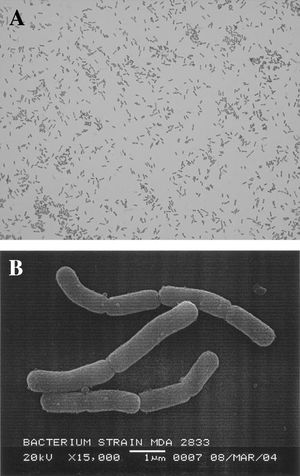Neisseria elongata: Difference between revisions
| Line 17: | Line 17: | ||
[[Image:Zjm0020661710002.jpg|thumb|Gram staining (magnification, ×1,000) (top) and electron microscopy (bar, 1 μm) (bottom) of MDA2833, a bacillary Neisseria sp.]] | [[Image:Zjm0020661710002.jpg|thumb|Gram staining (magnification, ×1,000) (top) and electron microscopy (bar, 1 μm) (bottom) of MDA2833, a bacillary Neisseria sp. From the American Society of Microbiology]] | ||
==Description and significance== | ==Description and significance== | ||
Revision as of 17:07, 28 August 2007
A Microbial Biorealm page on the genus Neisseria elongata
Classification
Higher order taxa
root; cellular organisms; Bacteria; Proteobacteria; Betaproteobacteria; Neisseriales; Neisseriaceae; Neisseria
Species
|
NCBI: Taxonomy |
Neisseria elongata
Description and significance
Neisseria elongata, formerly known as Centers for Disease Control (CDC) group M6, was described by Bovre and Holten in 1970 as a gram-negative, rod-shaped bacterium of the family Neisseriaceae, where it is found in the oral bacterial flora of the human pharynx and throat or in the blood of those infected (2). N. elongata consists of three subspecies, N. elongata subsp. elongata, N. elongata subsp. glycolytica, and N. elongata subsp. nitroreducens, in which are separated based on their biochemical differences (3). Although these subspecies of N. elongata were previously believed to be nonpathogenic to humans, recent case studies from patients suffering from endocarditis, have indicated that all three N. elongata subspecies are associated with human disease, particularly endocarditis and osteomyelitis (2).
Although the N. elongata genome has not yet been sequenced, the importance of sequencing its genome will provide information on the three N. elongata subspecies that could possibly assist in distinguishing their pathogenic roles in endocarditis and osteomyelitis. Before the pathogenic roles of all three N. elongata subspecies were discovered, where N. elongata subsp. nitroreducens was the first subspecies to be discovered as pathogenic, N. elongata subsp. elongata and N. elongata subsp. glycolytica were considered just to be transient colonizers of the human upper respiratory tract and urogentical tract (3). Thus, the sequencing of their genomes could possibly provide further insight into the differences and similarities involved in the factors influencing the metabolism and virulent features of the three N. elongata subspecies.
Genome structure
Describe the size and content of the genome. How many chromosomes? Circular or linear? Other interesting features? What is known about its sequence? Does it have any plasmids? Are they important to the organism's lifestyle?
Cell structure and metabolism
N. elongata is a nonmotile, aerobic, catalase-negative, asaccharolytic, oxidase-positive, urea-negative, gram-negative coccobacilli with an optimal growth temperature at 35 degrees Celsius (4). Before the isolation and characterization of Neisseria bacilliformis, the second and more recent bacilliary Neisseria species that was isolated from human infections, N. elongata was the only bacillary Neisseria species derived from humans. The rod-like shape of N. elongata makes it unique from the other Neisseria species, which are either cocci or diplococci (5). Thus, it is critical to avoid classifying N. elongata strains based on the diplococcal morphology typically associated with the majority of the Neisseria species.
The classification of N. elongata into three different subspecies, N. elongata subsp. elongata, N. elongata subsp. glycolytica, and N. elongata subsp. nitroreducens, are based on the biochemical differences between each subspecies. N. elongata subsp. nitroreducens are different from N. elongata subsp. elongata and N. elongata subsp. glycolytica in its ability to reduce nitrate (6). N. elongata subsp. glycolytica differs from the other subspecies based on its feature of testing positive for catalase, an enzyme involved in the decomposition of toxic hydrogen peroxide to water and oxygen (4). N. elongata subsp. elongata differs from the other two subspecies due to its inability to produce acid from D-glucose (3).
Being strictly aerobic, N. elongata requires oxygen to oxidize substrates in order to obtain energy. The ability of N. elongata subsp. glycolytica and N. elongata subsp. nitroreducens to produce acid from D-glucose is another method of energy acquisition, as an accumulation of small amounts of acidic intermediates are formed when glucose is broken down.
Ecology and Pathology
Describe any interactions with other organisms (included eukaryotes), contributions to the environment, effect on environment, etc.
Current Research
Enter summaries of the most recent research here--at least three required
References
(1) NCBI: Neisseria elongata, Accessed August 26, 2007, <http://www.ncbi.nlm.nih.gov/Taxonomy/Browser/wwwtax.cgi?mode=Info&id=495&lvl=3&lin=f&keep=1&srchmode=1&unlock>
(2) Haddow L. J., Mulgrew C., Ansari A., Miell J., Jackson G., Malnick H. and Gogal Rav G. “Neisseria elongata endocarditis: case report and literature review,” “European Society of Clinical Microbiology and Infectious Diseases.” 2003. Volume 9. p. 426-430.
(3) Anderson B. M., Weyant R. S., Steigerwalt A. G., Moss C. W., Hollis D. G., Weaver R. E., Ashford D., and Brenner D. J. “Characterization of Neisseria elongata subsp. glycolytica Isolates Obtained from Human Wound Specimens and Blood Cultures,” “Journal of Clinical Microbiology.” 1994. Volume 33. p. 76-78.
(4) Apisarnthanarak A., Dunagan C., and Dunne M. Jr. “Neisseria elongata subsp. elongata, as a cause of human endocarditis,” “Diagnostic Microbiology and Infectious Disease.” 2001. Volume 39. p. 265-266.
(5) Han X. Y., Hong T., and Falsen E. “Neisseria bacilliformis sp. nov. Isolated from Human Infections,” “Journal of Clinical Microbiology.” 2005. Volume 44. p. 474-479.
(6) Grant P. E., Brenner D. J., Steigerwalt A. G., Hollis D. G., and Weaver R. E. “N. elongata subsp. nitroreducens subsp. nov., Formerly CDC Group M-6, a Gram-Negative Bacterium Associated with Endocarditis,” “Journal of Clinical Microbiology.” 1990. p. 2591-2596.
(7) Wong J. D., and Janda M. “Association of an Important Neisseria Species, Neisseria elongata subsp. nitroreducens, with Bacteremia, Endocarditis, and Osteomyelitis,” “Journal of Clinical Microbiology.” 1991. Volume 30. p. 719-720.
Edited by Cindy Wu, student of Rachel Larsen

